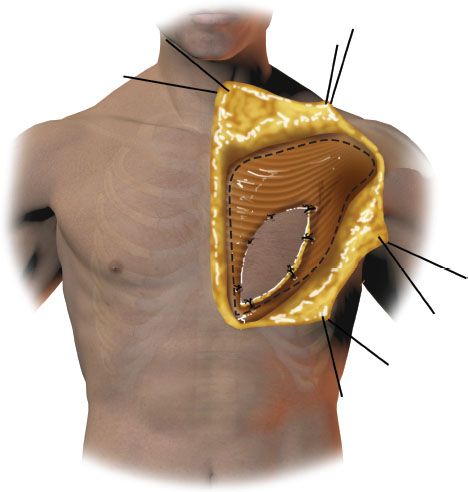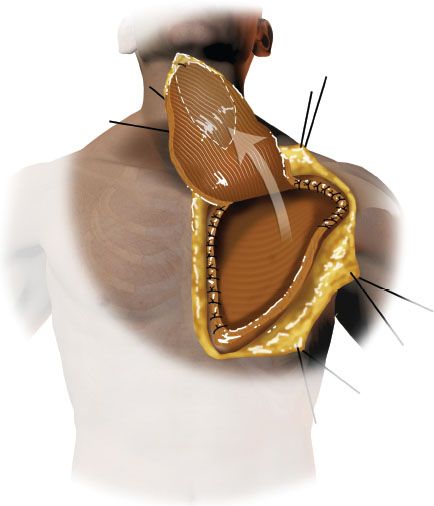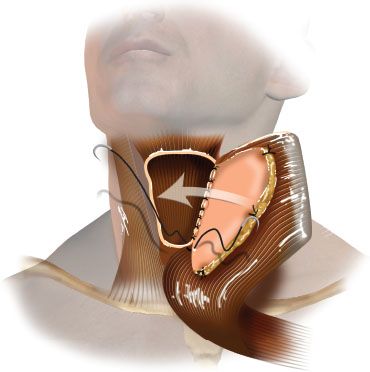FIGURE 29.1 The incision design for the harvest of the PMM flap. The incision for the skin paddle is designed as an ellipse centered over the pectoralis major muscle. This allows a greater potential capture of perforating vessels to the skin island. The ellipse also facilitates closure of the donor site.

FIGURE 29.2 The incision is taken through the underlying dermis and then sloped slightly to harvest a greater amount of subcutaneous adipose tissue over the muscle. This allows a greater potential capture of perforating vessels to the skin island.
At this point, similar tacking sutures are placed in the medial portion of the skin island securing it to the muscle. The tacking sutures are removed once the flap is delivered into the neck, and the skin island inset contouring is begun. There will usually be a distal segment of the large ellipse that will overlie the rectus fascia. A small square of rectus fascia overlying the lower ribcage is harvested with this distal segment of flap. This fascia will have adhesions to the pectoralis major muscle and will maintain its connection with it upon elevation. The potential use of the fascia later in the reconstruction is described.
With the skin island secured to the muscle and the vascular pedicle identified, the flap is elevated from inferiorly to superiorly off of the chest wall using electrocautery (Fig. 29.3). At the inferior level of the sternum, the muscle can be taken directly off the ribcage as it is elevated superiorly. As the first and second ribs are approached, it is important to leave a 2-cm cuff of muscle medially to preserve the perforating vessels toward the deltopectoral flap. The skin flap is then completely elevated superiorly to the clavicle. Dissection of the muscle as it approaches the clavicle is done carefully with visualization of the main pedicle of the flap to preserve its integrity. The humeral head of the pectoralis muscle must be severed to allow adequate rotation of the flap into the cervical defect, and this is done with direct visualization of the pedicle. Full mobilization of the flap will often require sacrifice of the lateral vascular pedicle, which can be done with minimal risk to the viability of the flap if there is a prominent main pedicle. The flap is then folded superiorly, and the distal rectus fascia is held with a clamp and pulled through the tunnel to deliver the flap into the cervical region. The skin island should now be facing toward the spine.

FIGURE 29.3 The pectoralis muscle is then gently elevated with its underlying fascia in the plane superficial to the fascia of the pectoralis minor muscle.
Complete hemostasis is obtained at the donor site. Specific care is then taken to insure that all of the per-forating vessels from the thorax to the muscle have been adequately addressed. Specific care is taken during elevation not to burn or injure the perichondrium and periosteum of the ribcage as this can lead to poor wound healing. The stump of the pectoralis muscle at the humeral head is now oversewn using a large suture in a running locking fashion. Two large-bore drains are placed exiting inferiorly. The skin flaps are mobilized laterally and medially to allow primary closure with the least amount of tension.
Prior to closing the donor site, the positioning of the vascular pedicle is examined as is the skin color and integrity of the skin island to confirm that there are no venous or arterial problems after transfer into the cervical region. Perforating motor nerves are severed during the elevation off the pectoralis minor muscle. There still can be significant neural elements closely approximated to the vascular pedicle, which may upon inspection have a constricting effect on the pedicle. If this is the case, these nerves can be severed using a nerve stimulator for guidance. Unlike reconstructive efforts that require rotation of the skin island to lie externally, in which these pedicle-associated nerves should always be severed, these nerves may not require direct attention during pharyngoesophageal reconstruction.
Partial Laryngopharyngectomy Defect
Using the PMM flap for partial laryngopharyngectomy defects is a straightforward endeavor. The flap is now placed into the midline cervical region overlying the proposed defect. The proximal part of the skin island, which will correspond to the lower portion of the neopharyngeal closure, is trimmed in appropriate fashion to have an adequate tension-free position. In a similar manner, the decision is made as to the appropriate length of the flap and width of the distal segment of the pectoralis skin island to fit into the defect of the base of the tongue (Fig. 29.4). Care is taken to leave the underlying rectus fascia as this will be used to reinforce closure at the base of the tongue.

FIGURE 29.4 The pectoralis muscle and skin paddle are rotated into the pharyngeal defect for the final reconstruction.
Attention is first turned to completing the closure at the lower esophageal segment taking care to contour the lower flap and allow the 270-degree closure around the esophagus. Usually, 3 cm of skin is required for this. Now 3-0 Vicryl sutures are used in an interrupted fashion to closely approximate the skin to the mucosa and submucosa of the esophagus and remaining posterior pharyngeal mucosa (Fig. 29.5
Stay updated, free articles. Join our Telegram channel

Full access? Get Clinical Tree


